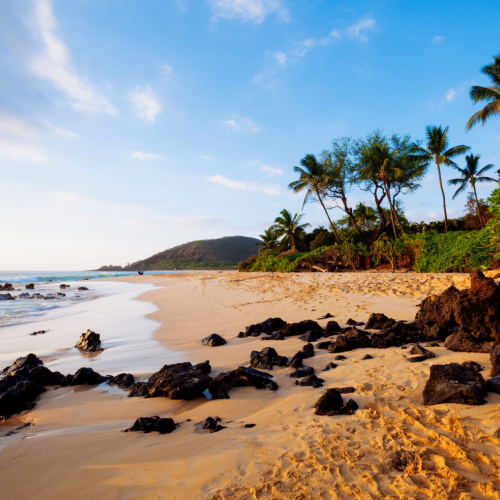
tropicdreams/Shutterstock
When Is the Best Time to Visit Hawaii?
The best time to visit Hawaii is between April to May (late spring) and September to October (early fall). The end and start of Hawaii’s spring and fall shoulder seasons provide unexpected periods of great weather, fewer tourists, and more affordable prices.
Visiting Hawaii during the shoulder seasons comes with several special benefits:
- Mild weather: Hawaii’s tropical climate is comfortable year-round, but late spring and early fall are when you’ll find the most pleasant temperatures with occasional showers. Sunshine is a sure thing during these periods and you’ll find the conditions perfect for spending time on the beach, exploring the towns, and hiking through the lush rainforests or mountain paths.
- Smaller crowds: The peak season in Hawaii is during the winter, so you can expect smaller crowds of tourists around when you visit in the late spring or early fall. You won’t need to book your hotel as early to score a great room, more flights will be available, beaches like Waikiki will be less packed, and you’ll appreciate the shorter or nonexistent lines at popular restaurants and attractions like the Polynesian Cultural Center and Haleakala National Park.
- Lower prices: The cost of visiting Hawaii can be steep if you visit during the peak season, but during the shoulder seasons, it’s much more affordable. Fewer tourists means reduced demand and lower prices across the board on flights, hotels, food, and attractions. If budget is important for your trip, this is the best time to visit.
Hawaii has plenty of options for travelers during the spring and fall shoulder seasons:
- April to May: Expect highs from 79°F to 84°F in April and May as springtime begins to swell into summer. The weather is warm, sunny, and reasonably dry on some islands (though Hawai’i can be rainy this time of year). It’s a good time for swimming, surfing on Oahu’s North Shore, snorkeling in Kealakekua Bay, or hiking through the lush rainforests and volcanic mountains for stunning views.
- September to October: Early fall in Hawaii doesn’t have colorful foliage due to the tropical climate, but the warm air and highs between 82°F and 87°F make up for it! This time of year, you can watch the humpback whale migration, tour Kona coffee and fruit farms, take a refreshing swim, hike trails at Haleakala National Park, or explore bustling cities like Honolulu.
Visiting Hawaii can be great year-round, but coming in the late spring or early fall ensures a spectacular, affordable, and less-crowded experience in these remote and tropical islands.
 Average Temperatures by Month
Average Temperatures by Month
|
Jan |
Feb |
Mar |
Apr |
May |
Jun |
Jul |
Aug |
Sep |
Oct |
Nov |
Dec |
| Kauai |
78°
|
78°
|
79°
|
80°
|
81°
|
83°
|
84°
|
84°
|
83°
|
82°
|
81°
|
79°
|
| Maui |
73°
|
73°
|
74°
|
75°
|
76°
|
78°
|
79°
|
79°
|
79°
|
78°
|
76°
|
74°
|
| Oahu |
78°
|
78°
|
79°
|
80°
|
82°
|
84°
|
85°
|
85°
|
85°
|
84°
|
82°
|
79°
|
| The Big Island |
73°
|
73°
|
74°
|
75°
|
76°
|
78°
|
79°
|
79°
|
78°
|
77°
|
76°
|
74°
|
Climate in Hawaii
Summer Season in Hawaii
Summer in Hawaii is slightly hotter than the rest of the year, bringing temperatures that surge into the 90s with average highs between 75°F to 88°F. It's the dry season across the islands, making it a nice time for outdoor activities by the water to keep you cool. Swimming, surfing, snorkeling, diving, and boat excursions are great in the Hawaiian summertime.
Rainy Season in Hawaii
There's no true rainy season in Hawaii, but each island does experience an independent rainy season at different times of the year. Hawai'i, the Big Island, gets the most rain overall during the spring with up to 7.2" in April.
The rest of the islands see the most rainfall in the winter between November and March when temperatures hang between 68°F to 79°F. In true tropical fashion, rains in Hawaii don't last long and are quickly replaced by warm, sunny weather that's still great for outdoor activities.
Winter Season in Hawaii
Winter in Hawaii is a little wetter than the rest of the year, but that doesn't stop tourists from arriving on the islands in droves. It's the peak season for Hawaii with idyllic temperatures between 70°F to 80°F and prime chances for whale watching, outdoor activities, and water sports.
Rainfall varies by the island in the winter, but Oahu and Maui generally see the least rain (1.3" to 2.4" per month). Hawai'i and Kauai are a bit wetter with 3.8" to 5.2" per month between November and February.
Our Recommendations






